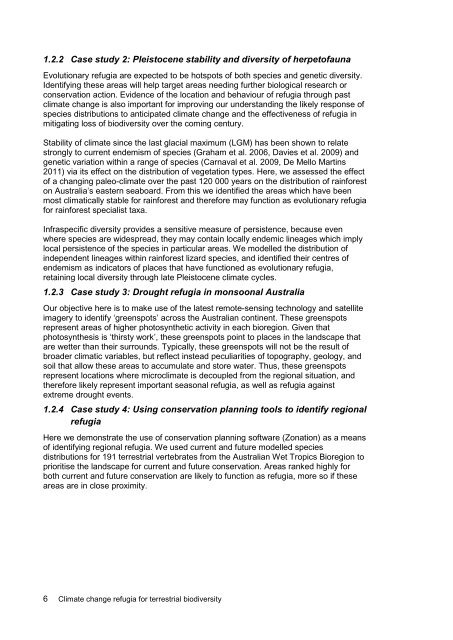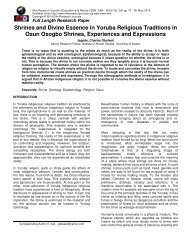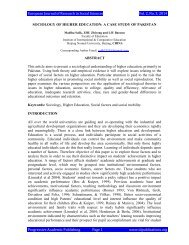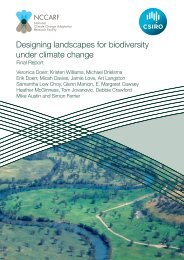Williams-Climate-change-refugia-for-terrestrial-biodiversity_0
Williams-Climate-change-refugia-for-terrestrial-biodiversity_0
Williams-Climate-change-refugia-for-terrestrial-biodiversity_0
Create successful ePaper yourself
Turn your PDF publications into a flip-book with our unique Google optimized e-Paper software.
1.2.2 Case study 2: Pleistocene stability and diversity of herpetofauna<br />
Evolutionary <strong>refugia</strong> are expected to be hotspots of both species and genetic diversity.<br />
Identifying these areas will help target areas needing further biological research or<br />
conservation action. Evidence of the location and behaviour of <strong>refugia</strong> through past<br />
climate <strong>change</strong> is also important <strong>for</strong> improving our understanding the likely response of<br />
species distributions to anticipated climate <strong>change</strong> and the effectiveness of <strong>refugia</strong> in<br />
mitigating loss of <strong>biodiversity</strong> over the coming century.<br />
Stability of climate since the last glacial maximum (LGM) has been shown to relate<br />
strongly to current endemism of species (Graham et al. 2006, Davies et al. 2009) and<br />
genetic variation within a range of species (Carnaval et al. 2009, De Mello Martins<br />
2011) via its effect on the distribution of vegetation types. Here, we assessed the effect<br />
of a changing paleo-climate over the past 120 000 years on the distribution of rain<strong>for</strong>est<br />
on Australia’s eastern seaboard. From this we identified the areas which have been<br />
most climatically stable <strong>for</strong> rain<strong>for</strong>est and there<strong>for</strong>e may function as evolutionary <strong>refugia</strong><br />
<strong>for</strong> rain<strong>for</strong>est specialist taxa.<br />
Infraspecific diversity provides a sensitive measure of persistence, because even<br />
where species are widespread, they may contain locally endemic lineages which imply<br />
local persistence of the species in particular areas. We modelled the distribution of<br />
independent lineages within rain<strong>for</strong>est lizard species, and identified their centres of<br />
endemism as indicators of places that have functioned as evolutionary <strong>refugia</strong>,<br />
retaining local diversity through late Pleistocene climate cycles.<br />
1.2.3 Case study 3: Drought <strong>refugia</strong> in monsoonal Australia<br />
Our objective here is to make use of the latest remote-sensing technology and satellite<br />
imagery to identify ‘greenspots’ across the Australian continent. These greenspots<br />
represent areas of higher photosynthetic activity in each bioregion. Given that<br />
photosynthesis is ‘thirsty work’, these greenspots point to places in the landscape that<br />
are wetter than their surrounds. Typically, these greenspots will not be the result of<br />
broader climatic variables, but reflect instead peculiarities of topography, geology, and<br />
soil that allow these areas to accumulate and store water. Thus, these greenspots<br />
represent locations where microclimate is decoupled from the regional situation, and<br />
there<strong>for</strong>e likely represent important seasonal <strong>refugia</strong>, as well as <strong>refugia</strong> against<br />
extreme drought events.<br />
1.2.4 Case study 4: Using conservation planning tools to identify regional<br />
<strong>refugia</strong><br />
Here we demonstrate the use of conservation planning software (Zonation) as a means<br />
of identifying regional <strong>refugia</strong>. We used current and future modelled species<br />
distributions <strong>for</strong> 191 <strong>terrestrial</strong> vertebrates from the Australian Wet Tropics Bioregion to<br />
prioritise the landscape <strong>for</strong> current and future conservation. Areas ranked highly <strong>for</strong><br />
both current and future conservation are likely to function as <strong>refugia</strong>, more so if these<br />
areas are in close proximity.<br />
6 <strong>Climate</strong> <strong>change</strong> <strong>refugia</strong> <strong>for</strong> <strong>terrestrial</strong> <strong>biodiversity</strong>






